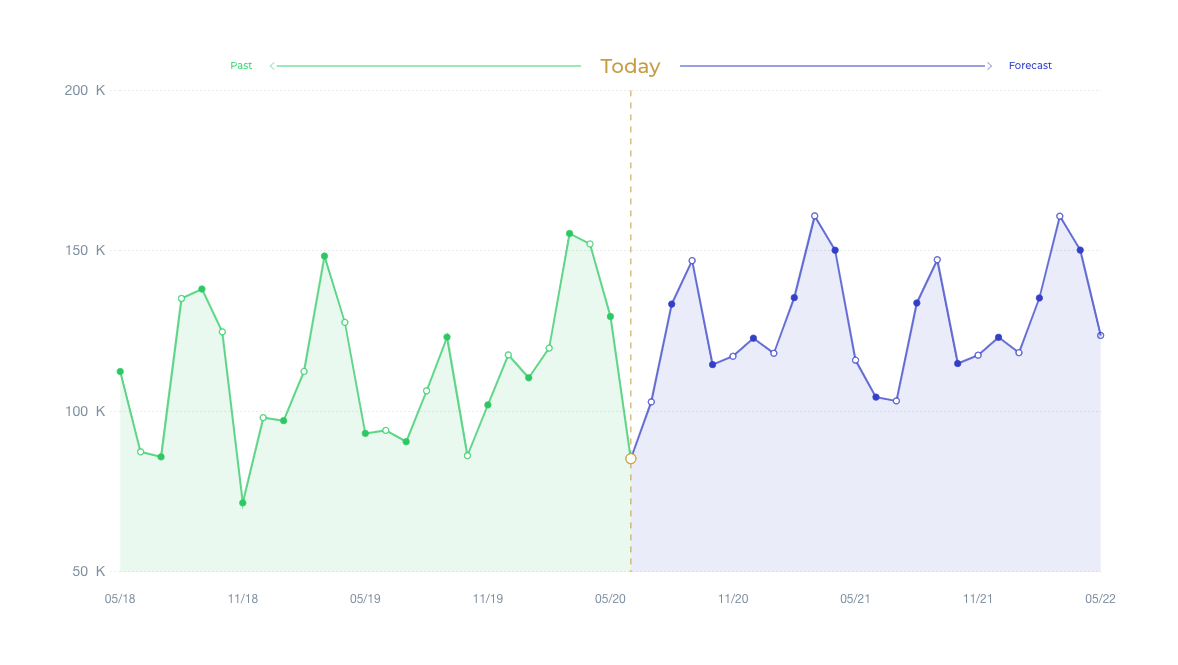Sales forecasting
and inventory optimization
Become a retail mastermind you always wanted to be.
Become a retail mastermind you always wanted to be.
Do you know how much business you will close next week? It can seem impossible to guess how much your business will earn in a week, a month, a year, or a quarter. But without this information, you are likely to miss important targets and be unable to run your business efficiently. Read on for 7 tips for how to accurately forecast sales.
A forecast is only ever as good as the data that is used to build it. Pulling from bad data will result in a bad forecast.
You need enough data to separate trends from blips. But it isn’t just a matter of making sure you load everything into your model. Too much history and you will be including data that no longer has any relevance.
Targeted marketing campaigns and new product introductions can easily skew you data. For example, sales of new products often start slow before ramping up as they hit their run rate values, or make a big impression to fulfil pent up demand before falling to run rate.
Make sure you prepare your data by trimming anything irrelevant from it before you start your forecast analysis.
No two sales and no two products are exactly alike. When looking at your data, you can’t treat it all the same. In order to become a highly effective, data-driven business you need to stop guessing and treat every datapoint as unique. Low volume, high volume, low profit, high profit – each product has unique attributes that contribute to your forecast.
Tracking your individual sales and products is vital when looking at your sales history. This not only gives you useful forecast data to anticipate and prepare for demand, it also allows you to look at how much each product is contributing to your sales. Without empirical data, it can be hard to gauge just how much time and money you are putting into each product, and how much profit they are generating.
A business can only hold so much inventory, so when a product produces more problems than profit, it may be time to consider retiring it.
Become a retail mastermind you always wanted to be.
While this is hard to predict in advance, as soon as it does happen you need to be responding to it. You can’t create a forecast at the start of the financial year and call the job done.
Sales don’t exist in a vacuum. You need to be constantly assessing your sales data, looking for unexpected upticks and downturns and adapting your forecast to them.
When looking at your sales, you need to account for seasonality.
This is the change in demand that regularly occurs throughout the year on an annual basis. Depending on your industry this may be a busy period around holidays, increased year-end spends or something else. If seasonality is very strong in your business, it can easily skew your forecast if not accounted for.
At the same time, it is important not to account for seasonality if it isn’t there. It is easy to look at similar spikes and troughs over a few years and expect it the next year. But if the seasonality isn’t consistent, you don’t want to include it in your forecast and then be left under target.
We’ve all been there. After a typical year, you suddenly close a big order that has a huge impact on your bottom line. You don’t want to include this next years forecast though – there is nothing to suggest this spike will happen again.
When looking at your sales history, you need to find and remove sales that are large enough that they are not likely to be repeated. Keeping stock back for these type of sales is never worth it.
One reason for troughs followed by small peaks in your sales history are stockouts. These are where you sell out of stock and are unable to fulfill new orders. Failing to remove these brings down your sales forecast, but will also make it difficult to plan for dips.
Looking at stockouts also gives us the opportunity to learn from previous mistakes and help reduce the chance of future stockouts. Failing to meet your delivery targets can have a big impact on the way customers perceive your business, so it is something you want to avoid wherever possible.
All this analysis is complex, time consuming and prone to errors.
Most people will quickly give up and use Excel spreadsheets to try and get a grasp of the data, but this stopgap is inefficient and brings it own problems. To provide transparent data for decision-makers, an automated forecasting system is required.
Different sales forecasting methods produce slightly different forecasts. Modern programs run forecasts based on many algorithms, finding the one, or combination, that works best for your business.
As you can see, transforming your sales pipeline and history into an up to date forecast can be a complex task. With so many factors to take into account, it can be almost impossible to do manually. So if you want to know how to accurately forecast sales, the only answer is automated forecasting. This will free up time and provide superior results compared to manually sifting through all your data.
If you want to save time and money with accurate forecasting, sign up and try Inventoro today. With an accurate forecast, you will know how much to order and when to order to meet demand.
Become a retail mastermind you always wanted to be.
